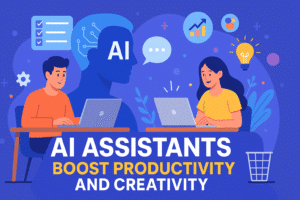ChatGPT, a powerful language model developed by OpenAI, has become a game-changer for businesses and individuals looking to boost productivity and efficiency. By automating tasks, generating content, and providing insightful data analysis, ChatGPT offers various ways on how to use ChatGPT to improve performance across multiple sectors. Whether you’re a business owner, content creator, or developer, learning how to leverage ChatGPT can transform your workflow. In this article, we will explore the benefits, practical applications, and costs of how to use ChatGPT to improve performance, along with a step-by-step guide to getting started.
What is ChatGPT?
ChatGPT is an AI language model that uses machine learning to understand and generate human-like text. Developed by OpenAI, ChatGPT can assist with various tasks, including content creation, customer support, and coding assistance. By processing large datasets, it learns to predict and produce text responses that are contextually relevant and useful. This makes it a versatile tool for improving performance across different industries.
Benefits of Using ChatGPT for Performance Improvement
- Enhanced Productivity
- ChatGPT can significantly speed up tasks such as content writing, data analysis, and project management. It helps teams focus on strategic activities by taking care of routine and repetitive tasks.
- Improved Customer Service
- By setting up automated responses, ChatGPT can handle customer inquiries around the clock. This reduces wait times and enhances customer satisfaction, freeing up human agents to tackle more complex issues.
- Streamlined Operations
- Automating processes like scheduling, data entry, and email follow-ups can streamline operations, making teams more efficient and reducing the chance of human error.
Practical Ways to Use ChatGPT to Improve Performance
- Content Creation
- ChatGPT can assist in creating various forms of content, such as blogs, social media posts, and reports. By inputting a clear prompt, you can quickly generate drafts that save time and effort. For example, businesses can use ChatGPT to write product descriptions, social media updates, or even complex technical articles to learn how to use ChatGPT to improve performance.
- Customer Support Automation
- ChatGPT can be integrated into customer support systems to answer common questions, troubleshoot issues, and provide information on products or services. This reduces the workload on human agents and ensures that customers receive quick, accurate responses.
- Data Analysis & Insights
- Businesses can use ChatGPT to analyze data sets and generate reports, simplifying tasks such as market research, sales analysis, and trend predictions. By summarizing complex data into digestible insights, ChatGPT helps teams make informed decisions faster.
- Coding Assistance
- Developers can use ChatGPT to write and debug code, making it a useful tool for software development projects. ChatGPT can help generate code snippets, suggest improvements, and even explain errors, streamlining the coding process and showing how to use ChatGPT to improve performance.
Costs of Using ChatGPT
ChatGPT offers both free and paid options:
- Free Version: Provides basic access but may have limitations on usage during peak times.
- ChatGPT Plus: Costs around $20 per month, offering faster response times and priority access, especially during high-traffic periods.
- API Usage: Businesses can integrate ChatGPT into their platforms via the API, which is billed based on usage. For detailed pricing, visit OpenAI Pricing.
When considering the cost, it’s important to weigh it against the potential time savings and productivity gains. For most users, the Plus version or API integration can pay for itself through improved efficiency.
Getting Started with ChatGPT
- Create an OpenAI Account: Sign up on the OpenAI website and explore available options.
- Choose Your Plan: Decide whether the free version meets your needs or if you should subscribe to ChatGPT Plus for additional features.
- Explore Features: Familiarize yourself with ChatGPT’s capabilities by testing it with various prompts.
- Set Up API Access: For businesses, integrating ChatGPT into existing systems through API access can streamline operations. Check out the API documentation for more information.

Best Practices for Maximizing ChatGPT’s Performance
- Provide Clear, Specific Prompts: The more detailed the prompt, the better the output.
- Use Pre-Training: Customize ChatGPT to better understand your brand’s tone and requirements by feeding it relevant data.
- Regularly Update Prompt Strategies: Continuously refine how you ask questions or give tasks to ChatGPT, adjusting based on feedback.
Conclusion
ChatGPT is a versatile tool that can enhance productivity, streamline customer service, and improve data analysis processes. Whether you’re looking to automate repetitive tasks, write content faster, or improve coding efficiency, ChatGPT offers practical solutions that can be tailored to your needs. Explore its potential by getting started with a free account or opting for more advanced features with ChatGPT Plus. Knowing how to use ChatGPT to improve performance can lead to substantial gains for any business or individual.












